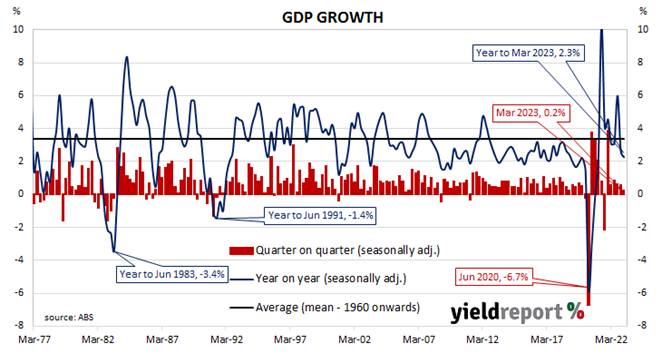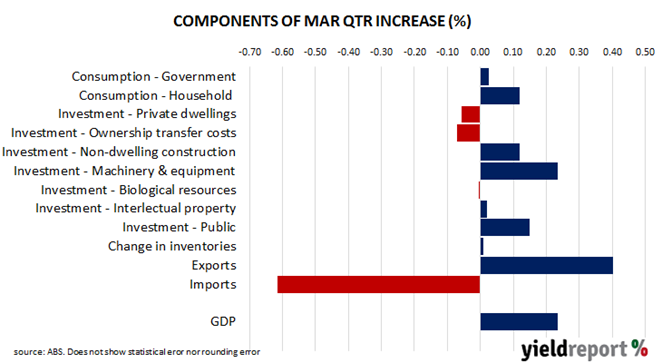Summary: Australia’s GDP up 0.2% in March quarter, less than expected; ANZ: business investment the one bright spot; spending on essentials increases, discretionary spending falls; exports, imports the major influences.
Since the “recession we had to have” as the recession of 1990/91 became known, Australia’s GDP growth has been consistently positive, with only the odd negative quarter here and there. However, Australia’s first recession in nearly thirty years was inevitable in 2020 once governments introduced restrictions which shut businesses and limited people’s movements for an extended period of time. Growth rates have been positive since then, although the September 2021 quarter proved to be the exception after restrictions were reintroduced in eastern states.
The latest figures released by the ABS indicate GDP rose by 0.2% in the March quarter. The result was slightly less than the 0.3% increase which had been generally expected and noticeably less than the December quarter’s 0.6% rise. On an annual basis, GDP expanded by 2.3%, down from 2.6% in the December quarter.
“The Q1 national accounts report showed activity continued to slow in the March quarter, as higher mortgage rates weighed on activity,” said ANZ senior economist Felicity Emmett. “Business investment was the one bright spot.”
Commonwealth Government bond rose on the day, especially at the short end. By the close of business, the 3-year ACGB yield had gained 6bps to 3.70%, the 10-year yield had added 3bps to 3.84% while the 20-year yield finished unchanged at 4.18%.
In the cash futures market, expectations regarding rate cuts in 2024 have been deferred until the second half of the year. At the end of the day, contracts implied the cash rate would rise from the current rate of 4.07% to average 4.14% in July and then to 4.255% in August. February 2024 contracts implied a 4.295% average cash rate while May 2024 contracts implied 4.14%, 7bps more than the current rate.
“Within the 0.2% increase in real household spending growth there were two distinct stories,” said Citi economist Josh Williamson. “Firstly, spending on essentials increased by 1.1%, thanks to increases in utilities, rent and other dwelling services, insurance and other financial services, health and education. Secondly, discretionary spending fell 1.0% thanks to declines in household equipment, alcohol, vehicles while recreation and culture was flat. “
Spending on imports increased by $3.4 billion, subtracting 0.60 percentage points from the quarter’s overall result, while a $2.2 billion rise in exports contributed 0.40 percentage points. Consumption growth added 0.15 percentage points while investment added 0.40 percentage points.



